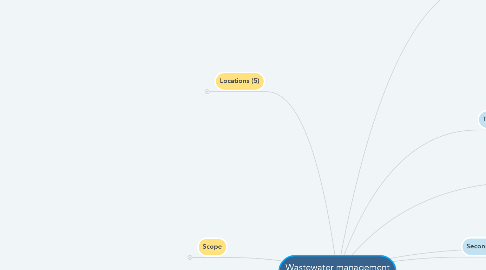
1. Locations (5)
1.1. Phisical/Topographical
1.1.1. Water Bodies
1.1.1.1. Pollution
1.1.2. Slope
1.1.3. Land
1.1.3.1. Cost
1.1.3.2. Crops
1.1.3.3. Availability
1.1.4. Existing sanitation infrastructure
1.1.5. Climate hazards / Risks
1.1.6. Wastewater Amount
1.1.6.1. population x black water/cápita = biogas potential
1.2. Social
1.2.1. population density
1.2.2. User description
1.2.2.1. Education
1.2.2.2. Occupation
1.2.2.3. Availability
1.2.2.4. Income
1.2.2.5. Economic activity
1.2.3. Social cohesion (groups)
2. Scope
2.1. On-site
2.1.1. Septic tank (HH) effluent is treated or discharged on the soil under the house
2.2. Off-site
2.2.1. Septic tank (HH) effluent is treated outside the house along other HHs effluents involves piping
3. Management
3.1. WHO
3.1.1. 1 Government (field facilitator, unit of sanitation) 2 Consultants (university, firm) 3 NGO (local, international) 4 Community base organization 5 Users 6 Private sector (contractor, cooperative) 7 Developer 8 University
3.2. WHAT (activity)
3.2.1. Design (1-7) Construction 1(finance) 3,4,5 Operations 4,5,6,7,8 Maintenance 4,5,6,8 Use 5,6
4. Toilets
4.1. Types
4.1.1. Squat toilet
4.1.1.1. less water
4.1.2. (Swan) toilete
4.1.2.1. more water
4.1.3. Pit latrines
4.2. Characteristics
4.2.1. no toilet paper
4.2.2. no automatic flush
5. Inputs
5.1. types
5.1.1. Blackwater
5.1.2. Greywater
5.1.3. kitchen waste
5.1.4. cattle manure
5.1.5. rain water
5.2. Indicators
5.2.1. Quantity (volume/time)
5.2.2. % of suspended solids
5.2.3. % of water
5.2.4. C and N content
5.2.5. BOD and COD
6. Pipes
6.1. Materials
6.2. Cost
6.3. Durability
6.4. Maintenence
6.5. Space configuration
6.6. Amount of conections
6.7. lenght
6.8. Capacity
6.8.1. Diameter
7. PrimaryTreatment
7.1. Anaerobic digestor
7.1.1. Multi Criteria Assessment
7.1.1.1. Components
7.1.1.1.1. Wet digestion
7.1.1.1.2. Filtration
7.1.1.1.3. Dry digestion
7.1.1.2. Economic Cost/Benefit
7.1.1.2.1. Start up costs
7.1.1.2.2. Maintenance cost
7.1.1.2.3. Operation and Maintenance costs (i.e. electricity, cost of labour)
7.1.1.2.4. Savings from cooking fuel
7.1.1.2.5. Affordability
7.1.1.3. Non-economic cost/benefits
7.1.1.3.1. Environmental parameters
7.1.1.3.2. Social/Governance
7.1.1.3.3. Technical parameters
7.1.1.3.4. Operational parameters (ease of use and robustness)
8. Secondary Treatment
8.1. Wetlands
8.1.1. Materials
8.1.1.1. Plants
8.1.1.1.1. Types?
8.1.1.2. Substrate
8.1.1.2.1. Medium
8.1.1.3. Construction
8.1.1.3.1. tanks
8.1.1.3.2. pipes
8.1.1.3.3. pumps?
8.1.1.3.4. liner
8.1.2. Subsurface
8.1.2.1. Flow direction
8.1.2.1.1. . Horizontal Vertical Efficiency - + Area + - Loading continuous interval Technicality - + Maintenance - + Evapotransp + -
8.1.3. Multi-criteria
8.1.3.1. Economic Cost/benefits
8.1.3.1.1. Start up costs
8.1.3.1.2. Operation and Maintenance costs (i.e. electricity, cost of labour)
8.1.3.2. Non-economic cost/benefits
8.1.3.2.1. Environmental parameters
8.1.3.2.2. Social/Governance
8.1.3.2.3. Technical parameters
8.1.3.2.4. Operational parameters (ease of use and robustness)
9. Outputs
9.1. Treated water
9.1.1. Total quantity
9.1.2. quality standards
9.1.2.1. desired
9.1.2.2. requiered
9.1.2.3. modelled/expected
9.1.3. Use options
9.1.3.1. irrigation
9.1.3.2. discharging
9.1.3.3. shower
9.1.3.4. flushing toilet
9.1.3.5. drinking
9.2. Fertilizer
9.3. Biogas
9.3.1. Characteristics
9.3.1.1. quantity
9.3.1.2. composition
9.3.1.3. use options
9.3.1.3.1. demand
9.3.1.3.2. management options
9.3.1.3.3. supply chain
9.3.1.4. Storage
9.3.1.5. Management
9.4. Waste
9.4.1. types
9.4.2. quantity
9.4.3. management
9.5. Plants
9.5.1. use
9.5.1.1. crop?
9.5.1.2. anaerobic digestor?
9.5.1.3. compost?

